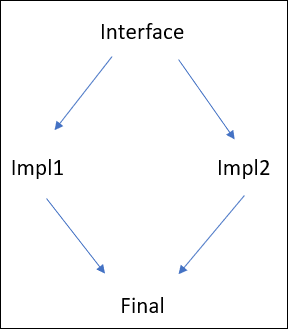AUTOSAR C++14 Rule A10-1-1
Class shall not be derived from more than one base class which is not an interface class
Description
Rule Definition
Class shall not be derived from more than one base class which is not an interface class.
Rationale
If a class inherits from multiple non-interface classes, the class essentially has access to multiple implementations. Maintaining the code can be difficult.
When a class inherits from multiple non-interface classes, there is a likelihood that the same member function exists in those base classes and must be overridden in the derived class. The likelihood increases when those base classes themselves inherit from a common base class (diamond structure).
Suppose, an interface class Interface has two concrete
implementations, Impl1 and Impl2, and a class
Final derives from both implementations. The class hierarchy has this
diamond structure.

The following issues can occur:
Overrides required in final derived class for disambiguation:
Both implementations
Impl1andImpl2have a copy of all methods of the classInterface. To disambiguate which copy can be called through aFinalobject, you typically create yet another override of all methods in theFinalclass where you call both copies explicitly using the scope resolution operator::(or one copy, if you choose). See example below.Each time you add a new pure virtual function to the class
Interface, you have to not only create implementations in the immediate derived classes but also keep track of the entire class hierarchy and create overrides of those implementations in the classFinal.If the original class
Interfaceis not an interface class, the problem is even more acute. Unless the inheritances are virtual, two copies of the methods ofInterfaceare implicitly made inImpl1andImpl2(the diamond problem).Final derived class responsible for initializing all classes in hierarchy:
To avoid double initializations in multiple inheritance, the C++ standard requires that you call the constructors of all previous classes in the most derived class.
In the preceding example, the
Finalclass constructor not only has to call the constructors ofImpl1andImpl2but also the constructor of their parent classInterface. You have to trace beyond the immediate parents to determine which constructors to call in the final derived class.
These problems disappear if multiple inheritances are restricted to situations where a
class can derive from multiple classes but only one of them can be a non-interface class. An
interface class is a class that has only pure virtual functions and data members that are
compile-time constants (static, contexpr-s). The class has no state and
its sole purpose is to be implemented by derived classes.
Multiple inheritance was designed for situations where a class extends one concrete implementation but also implements other ideas represented by interface classes. Other uses of multiple inheritance can lead to maintenance hazards.
Polyspace Implementation
The checker flags multiple inheritances where more than one base class is a non-interface class.
An interface class is one that has only pure virtual functions and data members that are
compile-time constants (static, contexpr-s). Any constructor or
destructor is set to =default or =delete.
Troubleshooting
If you expect a rule violation but Polyspace® does not report it, see Diagnose Why Coding Standard Violations Do Not Appear as Expected.
Examples
Check Information
| Group: Derived classes |
| Category: Required, Automated |
Version History
Introduced in R2020a